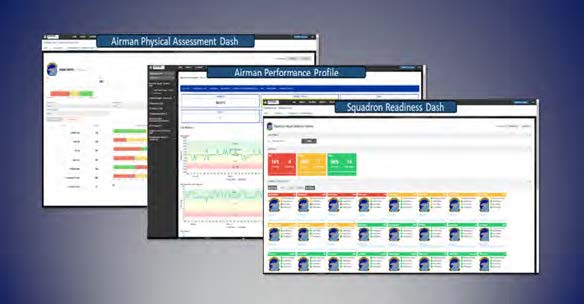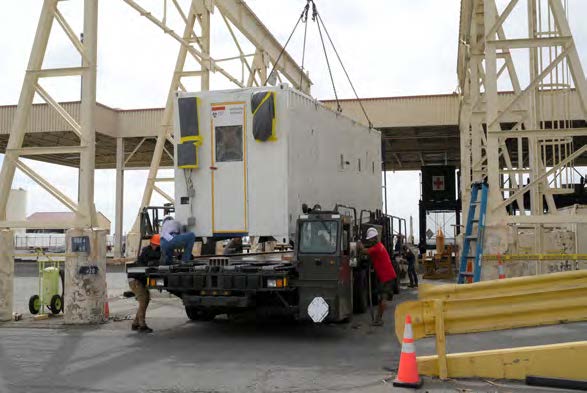The Air Force Research Laboratory has been supporting COVID-19 Operations and R&D Activities, mostly in our 711th Human Performance Wing (711 HPW), since the beginning of the pandemic. Researchers evaluated the past and present R&D efforts, repurposed them to address critical need, and pivoted to support the AF’s
COVID-19 response. This support comes in five broad categories: Detection, Decontamination, Patient Movement & Care, Data Analytics & Modeling, and Consultation.
EPIDEMIOLOGY REFERENCE LAB TESTING
AFRL’s Epidemiology Reference Laboratory, managed in the 711 HPW’s USAF School of Aerospace Medicine, has conducted more than 200K COVID-19 tests, including Navy’s Carrier Strike Group 11, and was able to implement the new Roche Molecular analyzer, which allows for 150 percent faster sample-processing time. The Epi Lab was also involved in evaluating the Abbott ID COVID-19 rapid test and the 3D-printed COVID-19 nasopharyngeal swabs.

PRE-SYMPTOMATIC SURVEILLANCE
The Airman Data Analysis and Performance Tracking System was repurposed to remotely monitor COVID-19 symptoms among Airmen being quarantined prior to deployment. This system has been used by medical groups at Hurlburt and Cannon AFBs. With these successes, the 711 HPW is now fielding inquires and requests from other medical groups required to enact the same pre-deployment procedures.

HIGHLY INFECTIOUS PATIENT TRANSPORT
After US Transportation Command (USTRANSCOM) published a joint urgent operational need statement for the transport of COVID-19 patients, the DoD developed and procured a new isolation containment chamber, the Negatively Pressurized Conex (NPC). AFRL’s human performance experts conducted critical horizontal and vertical acceleration tests of a modified C-17 side-facing troop seat for integration into the NPC and were subsequently recruited by the Air Force Life Cycle Management Center (AFLCMC) to be an integral part of the effort to modify the seat and achieve safe-to-fly and airworthiness status. The team’s recommendations led to seat design improvements including a 4-point harness, restraint net between seats, and foam head rest to reduce the risk of injury.
AFRL provided expertise on airflow modeling on aircraft in consideration of bio-aerosol transport in order to inform potential risks to air crews and mitigation measures if transport of COVID-19 positive patients is required and isolation units are not available. The team collaborated with AFLCMC to conduct 3-D mapping and airflow analysis of a C-17 to determine the unique flow characteristics within the cargo hold area to model coronavirus dispersion/exposure. The team also scanned the geometry and collected boundary-condition data for five additional airframes including KC-135, C-130J, C-5, KC-10 and KC-46, and built computational fluid dynamics models for airflow and bio-aerosol transport in the air mobility airframes evaluated. This work supports AFLCMC, Air Mobility Command (AMC), and USTRANSCOM.

COLLABORATIVE DECONTAMINATION TESTING
AFRL’s human performance experts teamed up with the lab’s materials and manufacturing experts to evaluate the effectiveness of the previously-developed Joint Biological Agent Decontamination System (JBADS) against COVID-19. In partnership with Battelle, the AFRL team developed a test plan to test decontamination conditions required for full effectiveness against multiple organisms including coronavirus and a surrogate phi-6 used by many, including the Navy, to simulate COVID responses. Results of tests have been shared with AMC and the JBADS program once. AFRL continues to evaluate the effectiveness of hot air against COVID-19.

PANDEMIC MODELING AND VISUALIZATION
Explainable artificial intelligence architecture using topologically-derived segmentation methodologies was used by AFRL’s human performance experts, in collaboration with MIT Lincoln Laboratory, to provide enhanced modeling capabilities responsive to queries across different regions for decision-making purposes. This enables commanders to identify real-time metrics to course correct, if needed. Dashboard models have been provided to Air Force Global Strike Command, A5/8/9, and the Department of Homeland Security.

CONSULTATION AND TRAINING
COVID-19-related Developmental/Tech-Push initiatives are tracking 200+ submissions on R&D ideas and information requests by a team co-led by the Air Force Medical Service Chief Scientist and the 711 HPW Chief Scientist. Group participants include key members connected to the Armed Services Biomedical Research Evaluation and Management Community of Interest Medical Countermeasures Task Force, Biomedical Advanced Research and Development Authority COVID response, and Air Force Futures, and the group is integrated with the Defense Health Agency for Defense Health Program research, development, test and evaluation resources.
Additionally, the 711 HPW is working with multiple partners in creating training for non-public health and non-medical personnel to trace contacts, reviewing concept of operation documents for returning to work, and reviewing medical literature on testing and screening guidelines to implement across Air Force work centers.
Finally, our infectious disease experts at the Center for the Sustainment of Trauma and Readiness Skills in Omaha have provided unparalleled consultative services and training to improve ground and transport medical care safety measures of COVID-19 infected patients for the DoD.

